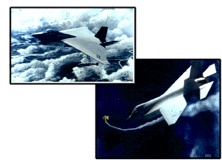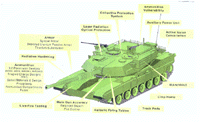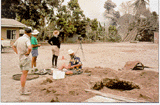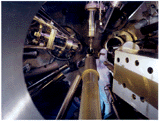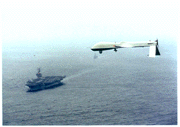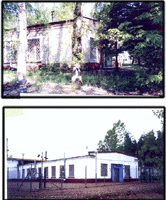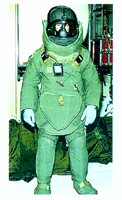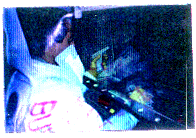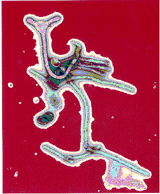![]()
|
NATIONAL SECURITY AND GLOBAL STABILITY
Science and Technology Assuring Our Preparedness and Improving Global Stability "Our nation's security derives from a combination of diplomatic leadership, economic vitality and military might. Advances in science and technology underlie our strengths, promoting stability through engagement, giving rise to new industries, and ensuring that our Armed Forces remain the best trained, best equipped, and best prepared in the world.
As our nation moves into the twenty-first century, we find ourselves faced with greater opportunities for peace and prosperity as well as new challenges to our nation's security and to global stability. The dissolution of a single major military threat has opened new opportunities for broadening peaceful alliances. It has been replaced, however, by an environment in which the dangers are more dispersed and increasingly varied. The accelerating diffusion of information, people, capital, and technology multiplies the paths to greater global prosperity and sustainable growth. However, it also raises the risk of proliferation of advanced weapons, including weapons of mass destruction, and of terrorist acts against the United States. Although the advance of all nations in commerce and trade bears hope for continued economic growth around the globe, increased consumption combined with demographic pressures from the world's expanding population aggravate large-scale environmental and resource degradation, which saps long-term economic strength and undermines political stability. All of these trends mean a greater interdependence among nations, in which the achievement of common interests can be more fully realized, but in which the ripples of negative events can propagate swiftly across the planet. The strategic development and use of science and technology strengthens our ability to meet these challenges. ENSURING THE NATION'S SECURITY THROUGH SCIENCE AND TECHNOLOGY
Meeting threats to stability and security requires an enduring
commitment to diplomatic engagement, military preparedness, and economic
performance. In each instance, our science and technology investments
and international cooperation play a key role. For over half a century,
scientific discovery and technological innovation have advanced our
military capabilities and economic prosperity, strengthening the United
States' position as the preeminent world leader.
SUSTAINING A STRONG MILITARY CAPABILITY
For decades, possession of superior technology has been a cornerstone of
U.S. military strategy. Technologies such as radar, jet engines, night
vision, the Global Positioning System, smart weapons, and stealth have
changed warfare dramatically. Maintaining this technological edge has
become even more important as the size of U.S. forces decreases and high
technology weapons become more readily available on the world market. In
this new environment, it is imperative that U.S. forces possess
technological superiority to ensure success and minimize casualties
across the broad spectrum of possible engagements. The technological
advantage enjoyed by the United States in Operation Desert Storm, and
still enjoyed today, is a legacy of decades of wise investments in
science and technology. Similarly, our warfighting capabilities ten to
fifteen years from now will be substantially determined by today's
investment in science and technology.
CHANGING THE FACE OF WAR
New technologies have dramatically enhanced our ability to both prepare
for and execute military actions. By supporting advances in information
technologies, sensors, and simulation we strengthen our ability to plan
and conduct military operations, quickly design and produce military
systems, and train our forces in more realistic settings. These
technologies are also central to greater battlefield awareness, enabling
our forces to acquire large amounts of information, analyze it quickly,
and communicate it to multiple users simultaneously for coordinated and
precise action. As former Defense Secretary William J. Perry has noted,
these are the technological breakthroughs that are "changing the face of
war and how we prepare for war."
BASIC RESEARCH: THE FOUNDATION OF DEFENSE SCIENCE AND TECHNOLOGY
The defense science and technology programs involve both long-term
research and near-term applications. By their nature, the end products
of long-term research are often difficult to predict, resulting in
applications not originally envisioned. Only in hindsight are we able to
appreciate all of the military advantages provided by breakthroughs such
as radar, digital computers, semiconductor electronics, lasers, fiber
optics, and highly accurate navigation systems.
|
|
APPLIED RESEARCH AND DEVELOPMENT
The Administration has designed a strategic approach to applied research and advanced development to get the most out of our defense science and technology investment in an increasingly difficult fiscal environment. The tri-service Defense Technology Area Plan comprehensively describes the investment strategy for critical defense technologies. It identifies the anticipat ed return on the science and technology investment through nearly 200 Defense Technology Objectives in ten broad technology areas. Each Defense Technology Objective identifies a specific technology advance that will be developed or demonstrated, the anticipated date that the technology will be available, and the specific benefits that should result. These benefits not only include increased military operational capabilities, but other important areas as well, including affordability and dual use applications.
|
|
NEW WAYS OF DOING BUSINESS
To increase the performance and reduce the costs of new defense
technologies, the Administration has launched initiatives that reflect
new ways of doing business. These new initiatives include policies to
strengthen acquisition reform, promote dual-use-technologies, and
sharpen technology demonstrations.
|
|
COUNTERING PROLIFERATION OF
Throughout the Cold War, the United States faced, in the Soviet Union,
an adversary armed with nuclear, chemical, and biological weapons.
During that period, the ability of each side to absorb an attack by
these weapons and still be capable of responding with a devastating
counterattack ensured that neither superpower used these frightful
weapons against the other. Today, the United States and Russia are
working together to reduce and dismantle the arsenals they built up
during the Cold War. However, we face a continuing challenge as these
types of advanced weaponry threaten to spread to other states and
nonstate actors around the world. |
|
DEFENDING AGAINST TERRORISM
The tragedy of terrorism has come closer and closer to home. The United
States had long been insulated from large-scale acts of terrorism until the terrorist attacks on the U.S. embassy and on U.S. forces in Lebanon in 1983, and the downing of Pan Am flig
ht 103 in 1988, killed hundreds of Americans. With the World Trade Center bombing in 1993 - intended to kill thousands - massive acts of terrorism came to our shores. The chemical attack against Tokyo subway riders in 1995 raised the prospect that weapons
far more devastating than conventional explosives were entering terrorist arsenals. Measures to prevent, minimize, and recover from acts of terrorism - whether via conventional, unconventional, or information attack-are essential, and must be undertaken a
t all levels, from the local to the international.
|
|
MOBILIZING SCIENCE AND
As one member of a global community, the United States shares with the world common threats and challenges to sustained economic development. Environmental degradation, natural resource depletion, natural disasters, and disease can have major consequences
that threaten every nation. The rapid growth of the world's population, projected to increase by up to one billion each decade, exacerbates many of these dilemmas. History has shown that population pressures can offset economic growth, lead to
unsustainable demands on food, other resources and the environment, and contribute to disorder and mass dislocations. These pressures threaten global stability and security and are likely only to grow more pressing with the passing of time.
|
|
STRENGTHENING OUR INTERNATIONAL
The Administration's strategy for applying science and technology to
meet these challenges builds upon the strengths of preventive diplomacy,
strategic engagement and international partnerships. Through preventive
diplomacy, the Administration endeavors to resolve problems, reduce
tensions, and defuse conflicts before they become crises. Employing
science and technology to bolster preventive diplomacy adds a new
dimension to our arsenal to promote stability and security. The
President's Committee of
Advisors on Science and Technology (PCAST) has stressed the
importance of this approach, noting that "what is required is a shift in
thinking akin to the change of emphasis in medicine from emergency rooms
and intensive care units to preventive primary care and public health."
FOSTERING GLOBAL PARTNERSHIPS
The Administration continues to work with other nations to build the
framework through which cooperation in science and technology can
strengthen our ability to stem global threats, foster sustainable
development, and advance areas of mutual interest. The Administration
has promoted the development of platforms for engagement through
bilateral commissions with nations including Russia, China, Ukraine,
South Africa, and Egypt; through priority bilateral science and
technology cooperation with key partners, including Japan and the
European Union; and through multilateral forums such as the Organization for
Economic Cooperation and Development, Asia
Pacific Economic Cooperation forum, and Summit of
Americas. These arrangements facilitate a constant dialogue among
science and technology policymakers, provide a steady framework to
promote and protect U.S. interests abroad, apply science and technology
more aggressively to meet our foreign policy priorities, and advance the
frontiers of knowledge by drawing on a greater range of resources.
Strategic engagement and international partnerships underlie our ability
to incorporate science and technology into our foreign policy goals. |
|
THE EVOLVING CHALLENGES OF THE FUTURE
|
|
OF OUR NUCLEAR WEAPONS
For over 50 years since the United States detonated the world's first
nuclear weapon in the New Mexico desert, weapons designers have relied
first on atmospheric testing, and later on nuclear tests conducted
underground, to verify the performance of nuclear weapons and to develop
new designs. Paramount was the need to ensure that the weapons in the
U.S. nuclear arsenal were reliable (would work as intended in a hostile
war environment) and safe (could not be set off accidentally).
|
|
The Advanced Concept Technology Demonstration (ACTD) program is the
Administration's approach to capturing and harnessing innovation for
military use rapidly and at a reduced cost. ACTDs are desinged to
foster an alliance directly between the technologists and the
operational users, eliminating barriers that can crop up between the
two. Representatives of the forces, including the Joint Staff, the
Joint Requirements Oversight Council, and the Commanders of Unified and
Specified Commands, play a direct role in the selection and management
of the ACTDs. |
|
The United States and the international community face the increasingly
pressing challenge of managing the flow of nuclear materials from cradle
to grave. Building on our work in the handling and disposition of
nuclear weapon materials, both at home and with the states of the former
Soviet Union, we must address all sources of nuclear materials, from
power plants to dismantled nuclear weapons. |
|
Today, an estimated 80 to 110 million landmines remain in places that
were once sites of conflict, killing and maiming more than 25,000
individuals per year. In addition to their costs in terms of human
suffering, landmines obstruct economic development programs and keep
refugees from returning to their homelands. Entire regions are denied
basic services because repairs to infrastructure are impeded,
humanitarian aid shipments are disrupted, and societies are thrown into
chaos. The vast majority of these landmines remain active for decades,
leaving a deadly legacy of conflicts that have long since ceased. |
|
Under the leadership of Vice President Gore, the United States is cooperating with South Africa in science and technology for mutual gain. Through our science and technology relationship, we are helping the new South Africa achieve its development goals of an adequate food supply, access to basic health care for all, and a stronger science and technology base. The United States is meeting its foreign policy objectives of building a stronger, more stable, and prosperous South Africa, which can serve as a foundation for democracy in the region. Moreover, science and technology cooperation will allow U.S. scientists to access important scientific data and will expand markets in South Africa for U.S. technologies by promoting joint technology development and creating a technologically literate South African workforce. |
|
On May 6, 1995, the U.S. Embassy in Zaire learned that Kikwit, an area
about 350 miles from Kinshasa, was suffering an outbreak of an unusual
hemorrhagic fever that had taken the lives of two Italian nuns. Several
days later, researchers at the Centers for Disease
Control and Prevention's (CDC) bio-safety level-four laboratory in
Atlanta, Georgia, confirmed that the mysterious outbreak was caused by
the deadly Ebola virus. First recognized in 19 76 during parallel
outbreaks in the Sudan and Zaire, Ebola has no known treatment or cure.
Before the Kikwit outbreak had run its course, 249 people died, nearly
one quarter of them health care workers.
At the same time, researchers report rapid progress in understanding the
course of the disease, and its molecular nature. In addition, a new skin
test developed by CDC scientists offers a safe way to send skin samples
from remote areas for identification in the high-security labs in the
United States, France, and South Africa. Researchers are also exploring
modes of transmission, including whether airborne droplets can spread
the infection, and are evaluating prospects for a vaccine. Scientists at
the Department of Defense have developed animal models of Ebola
infection for use in evaluating experimental therapies. National
Institute of Allergy and Infectious Diseases scientists are ass
isting them with the identification of experimental drugs to test.
|
|
SELECTED SCIENCE AND TECHNOLOGY ACCOMPLISHMENTS
A STRONGER DEFENSE
ARMS CONTROL AND NONPROLIFERATION
GLOBAL STABILITY AND PROSPERITY
|
TABLE OF CONTENTS | Chapter 4
